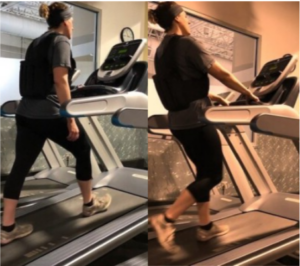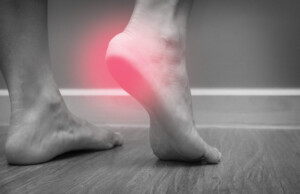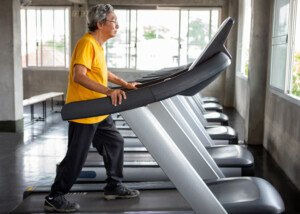
You may think holding onto a treadmill is safer than letting go, but it can set you up for several kinds of injuries.
It’s not safe to hold onto a treadmill because this can put you at risk for one or more of several types of injuries.
What kind of injuries or insults can holding onto a treadmill cause?
Here they are (no particular order):
Bad Posture (zero incline)
This is a no-brainer once you view the profile of someone holding onto a treadmill. A person’s height often dictates how their posture degrades.
Very tall people, while holding on, present with a forward head (think of a crow) and rounded shoulders.
They are slouched over so that their hands comfortably reach the rails or bar in front.
Over time, this forward posture can “mold” and becomes somewhat retained even after they get off the treadmill.
Short walkers will do the “shoulder bob” if they’re holding onto the side rails.
Sometimes this poking up and down of the shoulders is so pronounced, they can practically spin pizza dough on them!
With the shoulder bobbing comes tensed-up shoulder muscles.
All of this can lead to a repetitive stress injury: pain.
Hip Pain
A repetitive hip injury can result at fast speeds because the faster you walk when holding on (zero or inclined), the more the hips must abnormally rotate to compensate for the inertia of the upper body.
In normal walking, the upper body moves in rhythm with the lower body.
When you hold onto a treadmill, the upper body is frozen; it’s easy to see how this disturbs normal movement of the lower body and hips.
“It is possible that holding onto the treadmill while walking on it can lead to gait abnormalities that will cause hip pain,” says Bruce Pinker, DPM, who specializes in sports medicine and surgery of the foot and ankle.
“Especially while walking quickly (4-5 miles/hr.), can lead to gait disturbance if one is holding on,” continues Dr. Pinker.
“Our arm swing is an important part of walking, as it helps build momentum and provide balance.
Shoulder Pain (incline)
Leaning back with the machine’s angle, arms locked straight and tugging with each step, can cause a repetitive injury in the shoulder joints, though this is rare.

Left image is correct. The right is WRONG.
Those with elbow tendonitis may find this type of walking uncomfortable on those tendons, because grip-walking aggravates the tendons (if already inflamed) that control hand grip.
When I was a personal trainer I had a new client who reported mysterious chronic shoulder pain that would come and go, but she couldn’t associate it with any particular activity.
I soon learned she’d hold onto the treadmill when walking; I told her to swing her arms. The shoulder pain never came back.
Heel Pain
Plantar fasciitis can result from holding onto a treadmill simply because holding on causes an abnormal gait. This transfers down to the feet.

Plantar fasciitis often causes a burning sensation in the heel. Shutterstock/catinsyrup
If you have any kind of mysterious pain in the shoulder, neck, feet, and even back or knee, consider the possibility that the cause is holding onto a treadmill.
“Changing of the gait can always lead to injuries, especially soft tissue injuries such as tendinitis,” says Dr. Oliver Zong, a podiatrist (foot specialist), and director of surgery at NYC Foot Care.
He further explains: “To the extent that holding on to the treadmill changes one’s gait, this could happen. Clearly it is better to walk or run naturally with a natural gait pattern.”
To prevent falling off a treadmill, use a speed that you can manage without feeling you’re going to get tossed off the belt. Holding onto a treadmill, indeed, can cause injuries.
 Dr. Pinker is with Progressive Foot Care, which provides state-of-the-art, full diagnostic testing and treatment of the foot. He’s a professional foot and ankle health and wellness speaker who delivers many original seminars annually such as “Keep On Running.”
Dr. Pinker is with Progressive Foot Care, which provides state-of-the-art, full diagnostic testing and treatment of the foot. He’s a professional foot and ankle health and wellness speaker who delivers many original seminars annually such as “Keep On Running.”
Dr. Zong, a foot and ankle surgeon, has appeared on national and local TV programs such as “Good Morning America” and “The Doctors.”
 Lorra Garrick has been covering medical, fitness and cybersecurity topics for many years, having written thousands of articles for print magazines and websites, including as a ghostwriter. She’s also a former ACE-certified personal trainer.
Lorra Garrick has been covering medical, fitness and cybersecurity topics for many years, having written thousands of articles for print magazines and websites, including as a ghostwriter. She’s also a former ACE-certified personal trainer.
.










































